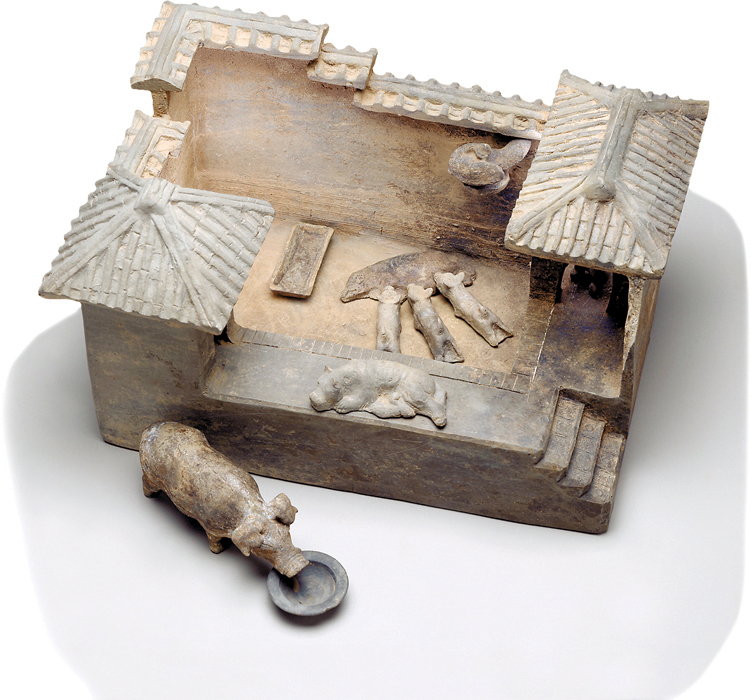A History of World Societies:
Printed Page 185
A History of World Societies Value
Edition: Printed Page 182
Life in Han China
How were ordinary people’s lives affected by the creation of a huge Han bureaucratic empire? The lucky ones who lived in Chang’an or Luoyang, the great cities of the empire, got to enjoy the material benefits of increased long-
The government did not promote trade per se. The Confucian elite, like ancient Hebrew wise men, considered trade necessary but lowly. Agriculture and crafts were more honorable because they produced something, but merchants merely took advantage of others’ shortages to make profits as middlemen. In a debate conducted in 81 B.C.E., the Confucian scholars argued: “If a country possesses a wealth of fertile land and yet its people are underfed, the reason is that merchants and workers have prospered while agriculture has been neglected.”4 This attitude justified the government’s takeover of the grain, iron, and salt businesses. Still, the government indirectly promoted commerce by building roads and defending cities.
Markets were the liveliest places in the cities. Besides stalls selling goods of all kinds, markets offered fortune-
Government patronage helped maintain the quality of craftsmanship in the cities. By the beginning of the first century C.E. China also had about fifty state-
Iron was replacing bronze in tools, but bronzeworkers still turned out a host of goods. Bronze was prized for jewelry, mirrors, and dishes. Bronze was also used for minting coins and for precision tools such as carpenters’ rules and adjustable wrenches. Surviving bronze gear-

The bulk of the population in Han times and even into the twentieth century consisted of peasants living in villages of a few hundred households. Because the Han empire, much like the contemporaneous Roman Empire, drew its strength from a large population of free peasants who contributed both taxes and labor services to the state, the government had to try to keep peasants independent and productive. The economic insecurity of smallholders was described by one official in 178 B.C.E. in terms that could well have been repeated in most later dynasties:
They labour at plowing in the spring and hoeing in the summer, harvesting in the autumn and storing foodstuff in winter, cutting wood, performing labour service for the local government, all the while exposed to the dust of spring, the heat of summer, the storms of autumn, and the chill of winter. Through all four seasons they never get a day off. They need funds to cover such obligations as entertaining guests, burying the dead, visiting the sick, caring for orphans, and bringing up the young. No matter how hard they work they can be ruined by floods or droughts, or cruel and arbitrary officials who impose taxes at the wrong times or keep changing their orders. When taxes fall due, those with produce have to sell it at half price [to raise the needed cash], and those without [anything to sell] have to borrow [at such high rates] they will have to pay back twice what they borrowed. Some as a consequence sell their lands and houses, even their children and grandchildren.5
To fight peasant poverty, the government kept land taxes low (one-
The Chinese family in Han times was much like Roman (see “New Influences and Old Values in Roman Culture” in Chapter 6) and Indian (see “Life in Early India” in Chapter 3) families. In all three societies senior males had great authority, parents arranged their children’s marriages, and brides normally joined their husbands’ families. Other practices were more distinctive to China, such as the universality of patrilineal family names, the practice of dividing land equally among the sons in a family, and the great emphasis placed on the virtue of filial piety. The brief Classic of Filial Piety, which claimed that filial piety was the root of all virtue, gained wide circulation in Han times. The virtues of loyal wives and devoted mothers were extolled in the Biographies of Exemplary Women, which told the stories of women from China’s past who were notable for giving their husbands good advice, knowing how to educate their sons, and sacrificing themselves when forced to choose between their fathers and husbands. The book also contained a few cautionary tales of scheming, jealous, manipulative women who brought destruction to all around them. One of the most commonly used texts for the education of women is Ban Zhao’s Admonitions for Women, in which she extols the feminine virtues, such as humility. (See “Individuals in Society: The Ban Family.”)